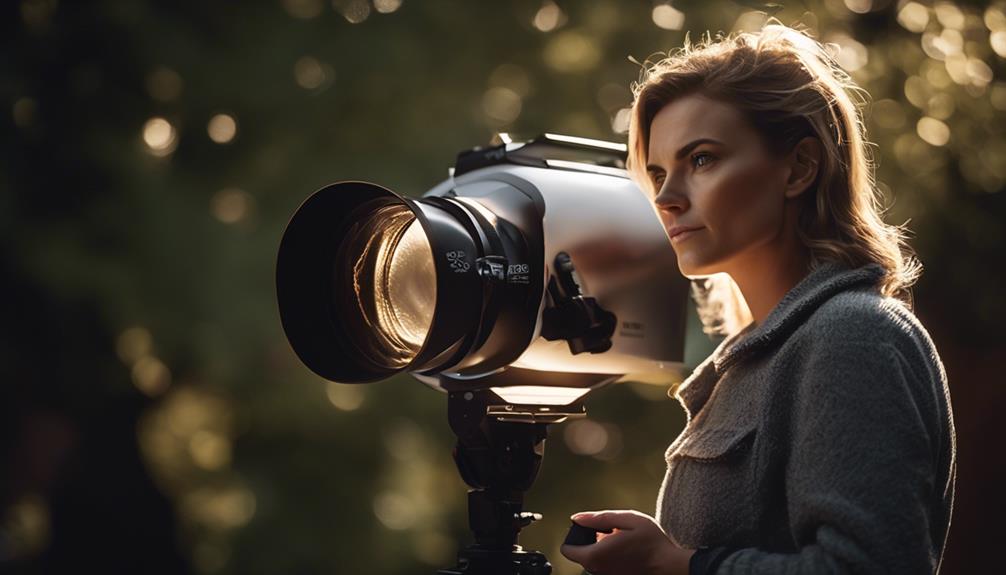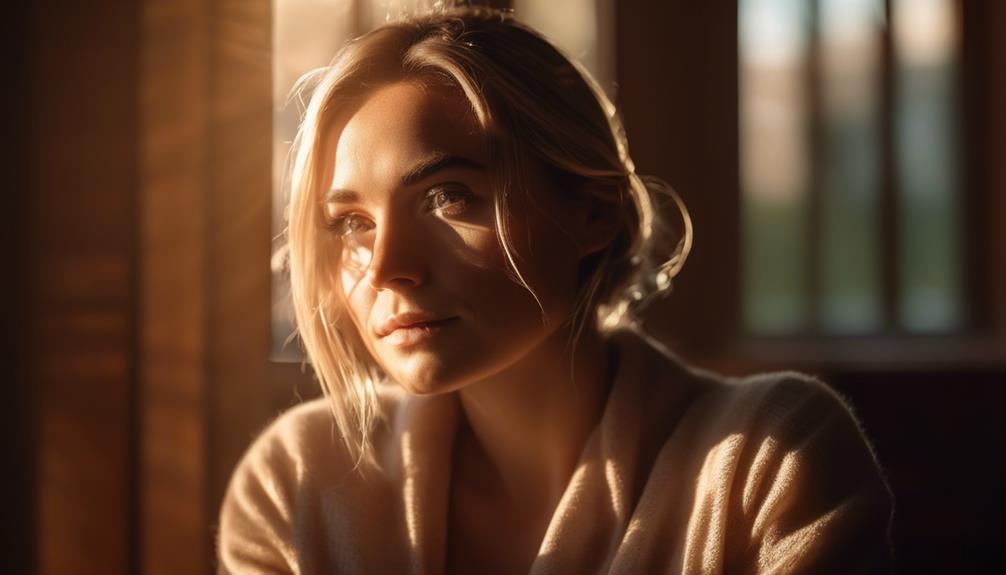Please note this post may contain affiliate links picked by me (Jay) that I have deemed may be of interest or relevant to you the reader of this.
These links do not affect the cost of the thing if you decide to purchase but i may get a little money if you choose to purchase.
For more information on my affiliate link policy click here.
As a photographer, I've come to realize that lighting is the key ingredient that can make or break a photograph. It acts as the conductor, orchestrating the mood, highlighting the subject, and adding depth and dimension to the image.
Just like a maestro leading an orchestra, mastering photography lighting techniques is a skill that requires practice, precision, and a keen eye for detail.
But fear not, for in this discussion, I'll share with you the first steps towards nailing these techniques, unlocking the potential to create captivating and visually stunning photographs that will leave your audience wanting more.
Key Takeaways
- Lighting techniques are crucial for creating visually striking images in photography.
- Understanding the principles of light and how it interacts with the subject is essential.
- Natural lighting and artificial lighting offer different creative possibilities.
- Mastering lighting techniques requires practice, experimentation, and attention to detail.
Understanding the Importance of Lighting
Understanding the importance of lighting is crucial for capturing stunning photographs. As a photographer, I've learned that lighting techniques for portrait photography play a significant role in creating visually striking images. Whether it's using natural light or artificial sources, mastering lighting can elevate the overall quality of your photographs.
One of the key aspects of lighting in photography is its ability to create mood and atmosphere. By manipulating light, you can evoke different emotions and set the tone for your photographs. Soft, diffused lighting can create a romantic and dreamy atmosphere, while harsh, directional lighting can convey a sense of drama and intensity.
To achieve the desired lighting effects, it's essential to understand the principles of light and how it interacts with your subject. Experimenting with different angles, intensities, and modifiers can help you achieve the desired results. Don't be afraid to get creative and think outside the box when it comes to lighting your subjects.
Furthermore, incorporating lighting techniques into your photography can bring innovation and uniqueness to your work. By mastering the art of lighting, you can create visually captivating images that stand out from the crowd. So, embrace the power of lighting and let it guide you towards creating stunning photographs that tell a story and evoke emotions.
Types of Lighting in Photography
As a photographer, I've discovered that mastering the different types of lighting in photography is essential for creating captivating and visually stunning images. Lighting can completely transform the mood and atmosphere of a photograph, so understanding how to use it effectively is key.
Here are three essential types of lighting in photography:
- Natural Lighting: Natural light is the most readily available and versatile source of lighting. It can create soft, diffused lighting for portraits or dramatic, directional lighting for landscapes. To make the most of natural light, it's important to observe how it changes throughout the day and adapt accordingly.
- Artificial Lighting: Artificial lighting refers to any light source that isn't natural, such as studio lights or flash units. This type of lighting gives photographers full control over the intensity, direction, and color temperature of light. It's commonly used in portrait, product, and fashion photography.
- Ambient Lighting: Ambient lighting is the existing light in a scene, such as streetlights or room lights. It sets the overall mood and can be manipulated to enhance the subject. Creative lighting techniques, such as using gels or bouncing light off reflective surfaces, can be used to modify ambient lighting and add a touch of innovation to your photographs.
Mastering Natural Light
Mastering natural light is an essential skill for any photographer looking to capture breathtaking images that showcase the beauty and authenticity of their subjects. Natural light has a unique quality that can enhance the mood and atmosphere of a photograph. One way to make the most of natural light is by enhancing shadows. Shadows add depth and dimension to an image, creating a sense of drama and intrigue. By positioning your subject in relation to the light source, you can manipulate the shadows to your advantage. Experiment with different angles and perspectives to create interesting and dynamic compositions.
Another technique to master when working with natural light is capturing golden hour moments. The golden hour refers to the period of time shortly after sunrise or before sunset when the light is soft, warm, and diffused. During this time, the sun is lower in the sky, creating long shadows and a beautiful golden glow. This magical light can transform an ordinary scene into something truly extraordinary. To capture the full beauty of the golden hour, it's important to plan your shoots accordingly and be prepared to work quickly, as the light changes rapidly.
Mastering natural light requires practice, patience, and a keen eye for detail. But when executed successfully, it can elevate your photographs to new heights, giving them a touch of magic and wonder. So, go out there, embrace the natural light, and let it guide you towards capturing stunning images that will leave your viewers in awe.
Exploring Artificial Light Sources
Now that we've successfully captured the beauty of natural light, let's venture into the realm of artificial light sources and discover the endless possibilities they offer in creating captivating photographs.
Artificial light allows us to have complete control over the lighting conditions, enabling us to experiment with different creative effects and techniques.
Here are three ways to explore and harness the power of artificial light:
- Studio Lighting: With studio lighting, you can create a controlled environment where you have full control over the intensity, direction, and color of the light. This allows for precise and consistent lighting setups, perfect for capturing portraits, still life, and product photography.
- Off-Camera Flash: Take your photography to the next level by incorporating off-camera flash. By positioning the flash away from your camera, you can create dynamic and dramatic lighting effects. Experiment with different angles, modifiers, and distances to achieve the desired mood and atmosphere in your photographs.
- Light Painting: Unleash your creativity by using light painting techniques. By using a long exposure and moving a light source around your subject, you can create mesmerizing light trails, shapes, and patterns. This technique adds a sense of magic and surrealism to your photographs.
Tips for Proper Lighting Setup
To achieve optimal lighting in your photographs, it is crucial to master the art of proper lighting setup. This involves understanding the different lighting equipment available and implementing effective lighting techniques. Let me share with you some valuable tips to help you set up your lighting for stunning results.
First, let's talk about lighting equipment. Having the right tools is essential for creating the desired lighting effects. Consider investing in a good quality camera flash, continuous lights, reflectors, and diffusers. These tools will give you more control over the lighting in your photographs.
Now, let me introduce you to some lighting techniques that can enhance your images. The table below summarizes these techniques:
| Technique | Description | Example |
|---|---|---|
| Three-point | Uses three light sources to achieve a balanced and professional look | Key light, fill light, and backlight |
| Rembrandt | Creates a dramatic effect by using a single light source that creates a triangular highlight on one side of the face | Side light positioned at a 45-degree angle |
| High key | Produces bright and evenly lit images with minimal shadows | Overexposing the shot and using soft, diffused lighting |
| Low key | Creates a moody atmosphere with strong contrasts and deep shadows | Underexposing the shot and using a single, focused light source |
| Backlighting | Illuminates the subject from behind, creating a halo effect | Positioning a light source behind the subject |
Frequently Asked Questions
How Can I Achieve a Soft and Flattering Light for Portrait Photography?
To achieve a soft and flattering light for portrait photography, I rely on a combination of techniques and the best lighting equipment.
By using diffusers and reflectors, I can soften harsh shadows and create a more even and gentle light.
Additionally, I love using a softbox or a beauty dish to achieve that perfect soft glow.
Investing in high-quality lighting equipment is key to capturing stunning portraits that truly showcase the beauty of your subject.
What Are Some Common Mistakes to Avoid When Using Artificial Light Sources?
When it comes to using artificial light sources for photography, there are some common mistakes that can really mess up your shots. But fear not, my fellow photographers, for I'm here to share some tips for using artificial light effectively and avoiding these pitfalls.
From overexposing your subject to forgetting to diffuse the light, I've seen it all. So pay attention, because with a little know-how, you can create stunning images that will leave your audience in awe.
Are There Any Specific Lighting Techniques That Work Best for Outdoor Photography?
When it comes to outdoor photography, there are some specific lighting techniques that can really make your images shine.
One tip for shooting in natural light is to pay attention to the direction of the sun. Shooting during the 'golden hour' when the sun is low in the sky can create a beautiful warm glow.
Another technique is to use reflectors to bounce light onto your subject and fill in any shadows.
These techniques can add depth and dimension to your outdoor photos.
How Can I Effectively Use Reflectors to Enhance Lighting in My Photographs?
I love using reflectors in my photography to enhance lighting and create dramatic effects.
It's amazing how a simple tool can make such a big difference!
Whether I'm shooting with natural light or using artificial light sources, reflectors help me bounce light back onto my subject, filling in shadows and adding dimension.
By strategically positioning reflectors, I can create stunning highlights and bring out the best in every shot.
It's a game-changer for sure!
What Are the Key Factors to Consider When Setting up a Lighting Setup for Product Photography?
When setting up a lighting setup for product photography, there are a few key factors to consider.
First, avoid common lighting mistakes such as harsh shadows or overexposure. Instead, focus on using natural light effectively to bring out the details and textures of the product.
Experiment with different angles and positions to find the perfect lighting that highlights the product's features and creates a visually appealing image.
Don't be afraid to get creative and innovate with your lighting techniques to make your product photos truly stand out.
Conclusion
So there you have it, the first steps to nailing photography lighting techniques!
Remember, lighting is crucial in creating captivating and professional-looking photographs.
Whether you're utilizing natural light or experimenting with artificial sources, understanding how light works and mastering its manipulation will greatly enhance your images.
And here's an interesting statistic to keep in mind: did you know that 85% of photographers believe that proper lighting is the most important factor in achieving a great shot?
So don't underestimate the power of lighting and keep practicing to perfect your skills!
Happy shooting!


